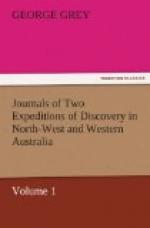In Mr. Earle’s translation of the account of the voyage of the Dutch colonial brig Dourga, which, it is stated, left Amboyna May 26th 1825 and visited the islands of Kissa, Lettee, Mon, Damma, Lakor, and Luan,* it is said, in speaking of them:
The clothing of those who cannot obtain European or Indian cotton cloth is pieces of prepared bark fastened round their waists.
The productions of these islands are sandalwood, beeswax, pearls, tortoiseshell, trepang, edible birds’ nests, Indian corn, rice, vegetables, with abundance of livestock. As the use of money is scarcely known these are only to be obtained by barter in exchange for cotton cloths, brass wire, iron chopping knives, and coarse cutlery. The first article, cotton cloth, is most in demand and M. Kolff suggests that a European merchant might carry on an advantageous trade here. The value of an ox is from 8 shillings and 4 pence to 10 shillings; of a sheep from 3 shillings and 4 pence to 5 shillings. Beeswax can be obtained in abundance at Roma at the rate of 2 pounds 7 shillings per hundredweight. The trade with the islands is carried on solely by natives, those of Macassar, Amboyna, and the Arru Islands being the chief purchasers; and Chinese brigs from Java occasionally visit Kissa.
(Footnote. The Serwatty Islands to the east of Timor see the map of the Asiatic Archipelago by Mr. John Arrowsmith.)
...
Geby, an island in the Gellola passage, has a fine harbour; a large quantity of tortoiseshell can be obtained there for trade with the natives. The Asia’s Islands, lying a short distance to the northward, are not inhabited but abound in turtle.
TRADE WITH THE ISLANDS OF THE ASIATIC ARCHIPELAGO.
The following points of information concerning the Indian Archipelago were furnished by Captain Brodie, formerly in command of a Dutch vessel of 326 tons:
In case of a necessity for repairing or coppering a vessel Surabaya is the best place as it can be done well and cheap. Wood for ship-building is abundant; and good carpenters can be had at the rate of 20 copper doits per diem, that is to say, three men for a rupee a day.
The Malaccas are under Dutch government, of which Ternate forms a part. It is said to be a good place to dispose of odds and ends,* and for getting a little shell. It is also a good place for refreshments.
Banda is not so good a place to go to, if another is at hand, as it is for a merchant vessel a strictly prohibited port. In fact the Spice islands, or Malaccas, can be entered for water and refreshments.
At Timor (Kupang) you can get sandalwood, wax, and a little shell, but dear.
At the north-east end of Celebes there are two other places, Monado and Keema, where the best gormootip or black coir rope can be obtained at about 7 rupees per picul. These two places are under the Dutch government. Some little business might be done there: stock in particular is cheap.




